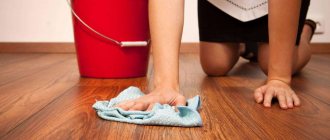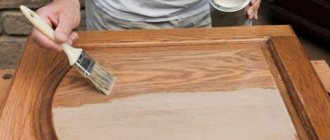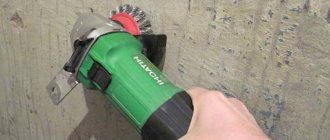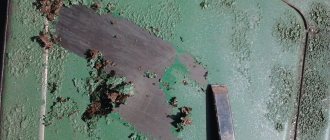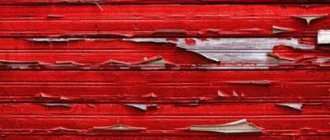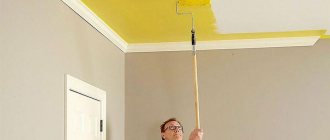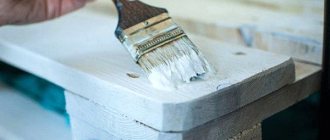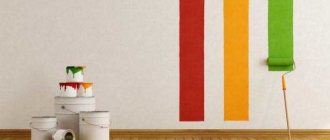What kind of paint can be applied to old paintwork?
Repair requires a lot of effort and time to make a high-quality update of the interior of an apartment or house. For this reason, many property owners want to reduce some of the work, especially when it comes to carrying out the finishing stage with their own hands. If the surface of the walls was previously painted, then beginners wonder: is it possible to apply paint over paint? The consequences of this decision, and in what cases this is permissible, will be discussed below.
Stage three: prepare the wall before leveling
In order for the putty to adhere well, you need to remove all loose particles, dust, oil stains, etc. from the wall surface. This can be done with a sponge soaked in soapy water. All cracks or holes must be widened using a hammer and chisel until they stop crumbling, and filled with putty.
After this, you should apply a primer - it will help make the wall equally porous over the entire surface to be treated, so that the leveling mixture will adhere better. Choose a special concrete-contact primer - it contains small particles (most often quartz sand) that make the surface rough, and its liquid base penetrates deep into the paint, increasing adhesion.
You can do without concrete contact, but then you will have to achieve the roughness of the wall in another way: you can process it with a drill with a special attachment, coarse sandpaper, or make notches in the paint with a sharp object. After this, go over again with a damp sponge to remove dust.
Can paint be applied to paint?
Professionals do not recommend painting over another coloring material. For them, the stage of removing the old finish is mandatory. The reason is the danger of peeling off the previous coating, and if you apply a new layer on it, it will suffer along with the old one.
Having painted a light color on top, there is a high probability of noticing dark spots appearing through it. All flaws in the previous finish will be noticeable. In addition, not all paints and varnishes are compatible; their components may not fit each other, the layer will not apply well, and the degree of adhesion will be low.
Applying one layer to another is permissible only if the first one is in good condition, if it is perfect and lies securely on the surface. It is advisable to use similar paints and varnishes; it is optimal to paint the wall with the same types of paints.
For professionals, the stage of removing the old finish is mandatory.
What kind of paint can be applied to oil paint?
If you need to paint in a short time and there is no way to waste time on removing the old finish, then there is an option when the paint layer can be applied to another one. You should check the integrity of the coating and whether it adheres firmly to the base.
The assessment is made visually; you should also run your hand over the surface; swelling can be detected using this method. If there are large defects, you cannot think about applying a new layer. Such a surface will repel new material quickly.
The oil composition has a glossy structure; it is the creation of an even film that helps protect the surface from moisture, for this reason it is often used for wood. But a smooth surface is not suitable for obtaining a good degree of adhesion. Therefore, the use of re-staining is difficult.
It would be correct to remove the paint; for this purpose, you can find special removers on sale; they soften the layer, after which you can remove the paint with a spatula. The process is not fast, but you get a good basis for repairs
If the base is in good condition, and you still decide to paint, then oil or alkyd enamel is more suitable for an oil base. You can also resort to acrylic; you will need to carry out the preparatory stage, applying a primer.
Compositions based on water are not a suitable option; in order to complete the polymerization, it is necessary to saturate the surface with water, and an oil coating will not allow it to pass to the base, so drying will not take place at the proper level, and reliable adhesion will not be obtained.
The oil composition has a glossy structure; it is the formation of an even film that helps protect the surface from moisture.
Step two: remove old paint
Which is better: heated floors or radiators?
Warm floorBatteries
Water-based paint dissolves easily with water, so to clean a wall of it, you just need to wet it and scrape it off with a spatula. Ideally, oil paint should also be removed; this can be done in three ways:
- Chemical - using special removers, after application of which the enamel dissolves and is easily removed with a spatula. The disadvantage of these compounds is toxicity: during their use and after, the room must be well ventilated.
- Mechanical - using a regular spatula, sander or iron brush. This method is the dirtiest: there will be a lot of dust, so you can’t do without a respirator.
- Thermal - using heating with a hair dryer, which softens the old paint and can be removed with a spatula.
If the paint sticks tightly and you can’t wash it off, we advise you not to waste your energy. It will be enough to simply clean the areas where the enamel does not adhere well. How to remove old paint from a plaster wall?
Then the wall is primed so that the putty will adhere tightly.
Is it possible to paint with oil paint over oil paint?
Is it possible to paint with oil paint over oil paint? Many property owners who decide to refresh the color of the walls ask this question. This option is optimal if you need to skip the stage of removing the old coating. To get better adhesion, it is advisable to sand the base, removing the glossy layer.
To get better adhesion, it is advisable to sand the base, removing the glossy layer.
Is it possible to paint with acrylic paint over oil paint?
The question of whether it is possible to paint with acrylic paint over oil paint can be answered in the affirmative. But a special type must be used - Master 121 paint. Taking into account that the surface has no flaws, the layer does not peel off or crack, only such a wall can be re-painted.
Master 121 is an acrylic enamel that is distinguished by its high adhesion to any type of substrate; it can even be applied to a glossy surface. This product will help to obtain a reliable and strong adhesion of the product to oil-type acrylic. But even the quality of good adhesion requires preliminary preparation of the base:
- First of all, the surface is sanded; fine-grained sandpaper is used for this purpose.
- The wall is washed, all dirt and grease should be removed.
- The surface must dry completely before painting; after the required time has passed, the wall is painted.
To improve the result, an equal amount of water should be added to the paintwork material; applying a more liquid product will make it easier to obtain an even and uniform distribution of the composition.
If you intend to distribute paint over the wall with a spray bottle, then you need to dilute it with special solvents.
Master 121 is an acrylic enamel that is distinguished by its high adhesion to any type of substrate.
Applying primer
Before applying the primer, you must follow the technology, which includes the following work:
- the glossy coating should be given a rougher structure; for this purpose, rough grinding is used;
- peeling old paint must be removed using a scraper, brush or other tool;
- the prepared surface must be degreased.
When priming, you should take into account the specifics of working with this material. The main requirement is a homogeneous structure.
Before painting, the primer must be thoroughly mixed. If the mixture is too thick, it should be diluted with plain water.
Allowable content is up to 10% of the total volume. Surface treatment with the finished composition can be done with a roller. With this tool, the soil is distributed more evenly, without smudges. When working with materials, builders and finishers recommend treating the surface from the bottom up. At the same time, there should not be too much solution on the roller or brush. This will prevent the occurrence of leaks. If you do not follow this, the finishing coating will lie unevenly, and defects in the work will be visible. A roller is a convenient tool for processing large areas.
Pay attention to: How to choose the right color for paint and work with it
A brush is suitable for priming awkward surfaces or too small parts. A good result can only be achieved with the integrated use of tools.
The primer will work well on acrylic paint, water-based paint, or oil composition; for this you just need to follow the technology.
Preparing the base
One of the stages of working with soil is preparing the foundation. It is produced in the following order.
Necessary:
- remove a layer of old paint using a scraper, brush, while capturing 5-10 cm of the surface from which the paint is difficult to scrape off;
- clean the surface that will be painted from dust, soot, and dirt using a sponge soaked in water and a suitable detergent;
- treat the prepared area with soil;
- apply putty to level the surface;
- Sand the area with fine-grit sandpaper once completely dry.
Is it possible to subsequently use water-based paint applied to the primer as the basis for another coating? Preparation is done in the same way.
Padding
It is necessary to adhere to priming technology, since this is a process on the correct implementation of which the strength and durability of the new paint coating depends.
Can a primer be applied to water-based paint? Most manufacturers indicate that their products are intended for such work.
Before starting the procedure, you need to make sure that the solution is homogeneous, fairly liquid, but not too much. To do this, the soil is thoroughly stirred immediately before working with it. Then it can be used for its intended purpose. For application, use a roller and brushes. Hard-to-reach surfaces and small elements can be passed with a brush. Large areas are treated with a roller. As necessary, it is moistened in the priming solution, and to prevent drips, it is squeezed well on a painting tray. To avoid the formation of streaks, the soil must be thoroughly rubbed into a fairly thin layer. After the first treatment, the second should be carried out. This is a necessary condition for obtaining good adhesion. Secondary primer treatment is carried out immediately after the already applied layer has dried. When carrying out work in a temperature and humidity regime favorable for repair (20-23 °C, 70-80%), the break between stages will be about an hour.
Can paint (paint materials) be applied to the primer after this? When the second layer has dried, you can begin the planned types of finishing work.
Important! Follow safety precautions! Although the primer is not a high-risk paintwork material, you need to work with it with extreme caution. To do this, it is recommended to work with gloves and special clothing. What should you do if the composition accidentally gets on your mucous membranes, especially your eyes? They should be rinsed with plenty of running water for 10-15 minutes. If you feel discomfort (itching, burning), you should consult a doctor.
Is it possible to paint with alkyd paint over oil paint?
Often windows, radiators, ceilings and walls are painted with oil-based compounds. However, modern technologies have made it possible to create more advanced types of paints, for this reason many want to replace the material. Alkyd enamel has many advantages.
If an alkyd resin-based paint is chosen to repaint the paint, then the old oil-based coating must be removed. Only if the previous finish is securely fixed can re-painting be allowed.
Then the wall is sanded, the remaining dust and dirt after the process is washed off with an aqueous solution with soda. After the base has dried, the finished solution can be applied; several layers will be required, it is important that each of them is completely dry.
If an alkyd resin-based paint is chosen to repaint the paint, then the old oil-based coating must be removed.
How to achieve better results
It is important to let the water-based paint dry after each coat. This requires at least four hours, depending on the type of emulsion. During work, you should periodically move away to different distances to see in which places the substance has not been applied enough.
In order for the ceiling to maintain its attractive appearance for a long time, it is necessary to protect it from sunlight for the first time after painting. You should also avoid drafts in the room. This will not speed up drying, but will only destroy the structure of the emulsion.
To prevent the formation of marks from the roller in the form of stripes, you need to do several rolls on the ceiling during work after the paint on the roller has run out. It is also important to control the load on the tool. The pressure on all sides of the roller should be equal. If dents are found during painting, then it will not be possible to remove this effect with water-based paint. In this case, you will have to remove all the old layers and re-plaster the ceiling. If you find traces from the roller in the form of stripes of different colors, you need to thoroughly mix the paint again and, changing the angle of view, check whether any areas are missing.
The result is largely determined by the quality of the materials used. When choosing water-based paint, you need to carefully study the label. You should select an emulsion specifically for ceilings, and also pay attention to the characteristics of the substance, such as composition and level of wear resistance.
Nowadays, there are many modern materials for finishing, both for walls and ceilings. Today, one of the most affordable types of ceiling finishing is painting with water-based paint. Manufacturers of this material offer a very large assortment of paints that will help you paint the ceiling
high quality.
Is it possible to paint with enamel over acrylic paint?
The acrylic type is distinguished by the presence of water in the composition, which contributes to the environmental friendliness of the composition, it does not smell unpleasant, and also does not emit harmful components when drying. The presence of water makes it possible to paint over other paints and varnishes, including enamels. First you need to clean the wall of dirt and apply a primer, then adhesion will be better. Of course, such finishing is only possible on strong substrates, without cracking.
The presence of water makes it possible to paint over other paints and varnishes, including enamels.
Is primer needed when painting a putty part?
Some craftsmen, in order to save money, try to paint completely puttied parts without primer. But the savings are negligible, meanwhile the quality of the painting suffers. The fact is that it is unlikely that it will be possible to wash off the putty so that after painting no risk appears. Usually they also add a developing layer to bring the polishing to perfection.
The pore size of filling primers is much smaller than that of automotive putties. Accordingly, the primer washes out much better. In addition, it fills in all surface defects of the putty itself. Therefore, it is necessary to prime the putty.
How to paint walls with water-based paint over oil-based paint
The water-based composition is also produced using water. To obtain the necessary fixation of the layer, it must be saturated into the base. But the oil composition will not give water such an opportunity, it will simply push it away from itself.
For this reason, part of the layer will adhere well, in those places where the gloss has come off, and part will simply not adhere. To avoid such consequences, apply a layer of drying oil; it will create a good base for adhesion. Or a primer solution is used.
To obtain the necessary fixation of the layer, it must be saturated into the base.
What kind of paint can acrylic paint be applied to?
To paint an oil base with an acrylic composition, first apply a primer mixture; it will create the necessary level of adhesion of the two products. The water-based base must be ideal, then it will be possible to apply an acrylic-based product. But it is always better to remove the previous finish. Then the coloring will be of high quality.
It is possible to use a latex layer on top; it is important that the acrylic is of high quality. Then the degree of adhesion will be good, the compositions will be able to adhere well.
It is possible to use a latex layer on top; it is important that the acrylic is of high quality.
Is it possible to paint with oil paint on nitro enamel?
The oil type of wall painting material has an oily structure that is poorly compatible with nitro enamels. If you apply them on top of each other, the following problems may appear:
- Formation based on cracks and bubbles;
- Changing the shade of the product, which ultimately will not allow you to get the desired design of the room;
- The paint life will be short.
The oil type of wall painting material has an oily structure that is poorly compatible with nitro enamels.
Advantages of water-based ceiling painting
Compared to other types of ceiling coverings, water-based ceilings have the following advantages:
- The coating is resistant to high humidity conditions.
- Environmentally friendly material. The paint does not emit toxic fumes even when the air temperature in the room increases.
- The water-based composition is easily applied using a brush, roller or spray gun.
- Compared to other paints and types of ceiling coatings, water-based emulsion has a reasonable price.
- By adding pigments you can get the desired shade.
- Paint ensures quick repair work and saves money.
Additional advantages of such paint coatings include the fact that they are suitable for application to concrete, wood and plasterboard surfaces. The question of how to wash a painted ceiling arises only in the kitchen, because in other rooms such coating does not require special care and cleaning.
Is it possible to paint with oil paint on enamel?
Oil base and enamels are similar in their components, which helps to use them together. If necessary, the formulations can be mixed together. It is also allowed to paint them on top of each other.
But the condition for the reliability of the base remains unchanged for any composition. The surface should be cleaned of all types of contaminants and thoroughly degreased. The new product should be applied in several layers. The importance of drying each one is undeniable, so don’t rush, otherwise the paint will be ruined and won’t last long.
The new product should be applied in several layers.
The article provided a detailed answer to the question: is it possible to apply paint to old paint? The technology of work includes the mandatory removal of old materials, but sometimes it is not possible to carry out this stage. Then the condition of the surface is assessed and compatible products are selected.
Rust
Is there any way to avoid completely removing the rust? Cleaning curved surfaces with your own hands, given their large area, is extremely tedious.
Solution
A rust converter will come to the rescue - a composition that chemically converts iron oxides into a durable insoluble coating. The price of a liter package is approximately 200 rubles.
Rust converter.
Technology
- Plate rust is removed with a spatula. The converter can change its chemical composition, but will not do anything with its spatial structure; the base for painting, as we remember, must be durable.
- Areas stained with lubricating oils or solarium are degreased with a solvent.
- The rust converter is applied with a sponge or brush. Painting is possible immediately after it has dried.
